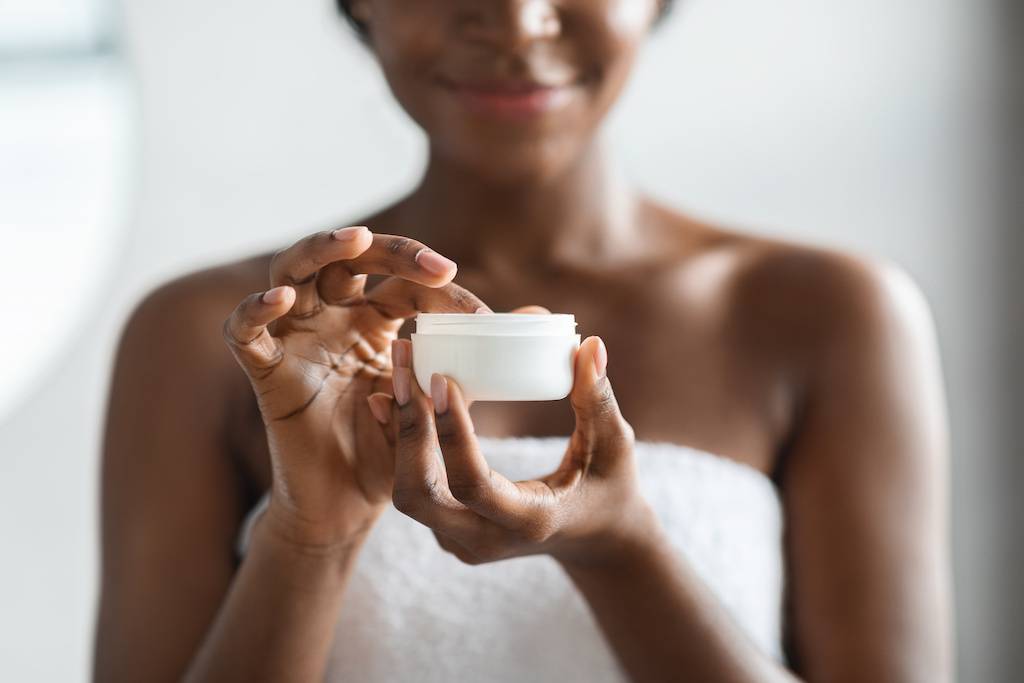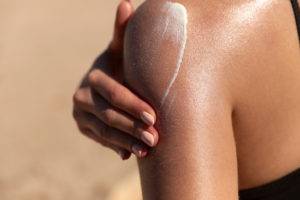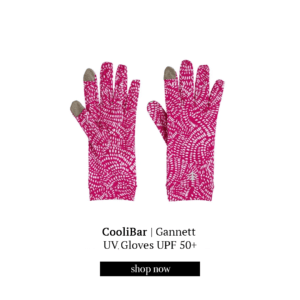Beauty...

By Elise Tabin
For most of us, the skin on our faces is the primary focus of our daily anti-aging routines. But skin exists beyond the face, and paying attention to it elsewhere on the body is equally as important.
Gone are the days of applying just a thin layer of body lotion and calling it a body care routine.
As body care becomes more mainstream, there’s interest in adequately tending to the skin from the neck down so that it’s glowy, firm, well-hydrated, soft to the touch, and better equipped to handle the effects of aging.

@adobestockimages
It’s a beauty fallacy that only the face needs a proper anti-aging skincare routine that consists of supercharged active ingredients. But that couldn’t be further from the truth.
If you want to keep the skin on the body looking plump and healthy and equipped to resist age-related changes, it too requires a skin routine that’s all it’s own.
The skin on the face is markedly unique from the skin on the body. According to dermatological nurse and celebrity aesthetician Natalie Aguilar, facial skin is about ten times thinner than the skin on the body.
There are also far more oil glands on the face than the body, which causes certain areas, especially the hands, feet, elbows, and knees, where the skin is thick and exposed more to frictional forces, to be more susceptible to dryness.
“The skin on the body is biologically distinct from the face, and they each experience different environmental exposures,” says New York dermatologist Brendan Camp, MD.
“Facial skin is exposed to the sun daily and requires a different treatment approach than elsewhere.”
New York dermatologist Marisa Garshick, MD, says that the skin on the body tolerates ingredients differently. “Therefore, you’ll probably prefer different strengths, concentrations, ingredients, and formulations for an anti-aging body routine versus what you use on your face,” she adds.
While we’re not saying that applying a face serum to your neck or a facial hydrating mist to your legs is completely useless, there are better ways to do it that are way more effective.
Aguilar states that most skin-care products are designed for a specific body part and goal.“For example, eye creams are meant to be used around the eye to address issues such as dryness, puffiness and dark circles. Similarly, foot creams are intended to soften hard calluses on the feet that don’t form elsewhere on the body,” she explains.
Aguilar also cautions against applying body products to the face, which can cause discomfort and sensitivities. “While you can use most facial products on the body, you still should be cautious. Applying retinol, glycolic and other acids can compromise the skin on the body.”
Skin everywhere on the body succumbs to the throws of aging and experiences a loss of collagen and elastin, discoloration, and creepy, saggy skin.
Dr. Camp notes that the more sun exposure the skin receives, the greater the effects of photo-damage, no matter where on the body it may be.
“Ultraviolet (UV) radiation accelerates aging by increasing the rate of collagen and elastic degeneration and contributes to forming free oxygen radicals, which damage cellular structures like DNA, lipids, and proteins.”
While the face is the sun’s most willing victim, the neck, upper chest (décolletage), and back of the hands are equally at risk. “The hands, neck and chest tend to show signs of aging because they are regularly exposed to the sun and often forgotten when it comes to routine sunscreen application,” Dr. Garshick shares. “Additionally, because the skin is thinner here, it is more likely to show signs of aging sooner than other areas on the body.”
While you may think, “I need another step in my beauty routine like I need a hole in my head,” caring for the skin on the body is relatively easy as long as you know what to use and where to take caution. And, while it goes without saying, sunscreen is a must–avoiding sun exposure will help save your skin.
If a golden glow is something you can’t part with, a self-tanner will become your best friend.
(image)
From body serums to supercharged hand creams and everything in between, here’s the lowdown on the body parts that require plenty of skin care TLC—and exactly how to do it.
The neck is an extension of the face, and many of us apply our face creams and serums to the neck.
Bringing the product straight down to the neck is the easiest way to treat the delicate skin, but you’ll benefit more from a routine that’s just for the neck. Dr. Garshick says hydrating ingredients, like hyaluronic acid, are critical for boosting moisture, while peptides and growth factors help increase collagen production.
“Antioxidants are also a must for helping to brighten the skin and protect it against free radical damage.
Retinol is great for cell turnover when used a few times per week or as tolerated given the potential for irritation on the neck,” she says. Since the skin on the neck veers towards the thinner side with few oil glands, look for lighter-weight formulations instead of super thick occlusive ones, potentially leading to breakouts. And, of course, don’t glaze over the sunscreen.
Once mild sagging of the neck starts, in-office solutions may become a staple. “Some treatments can help the neck, like neuromodulators, fillers, which help with horizontal lines, lasers like IPL to improve the skin tone, and laser resurfacing and microneedling to help address skin texture concerns, such as crepiness,” Dr. Garshick explains.
The chest is a little further down the road from the neck and an oft-forgotten body part that Aguilar says requires serious attention. “Paying attention to it helps it to age more uniformly with the face and neck,” she says.
Like the face, the chest can bear the brunt of a hefty dose of sun exposure and quickly become discolored, wrinkled and saggy. Even something as innocent as wearing a deep v-neck top (sans adequate sun protection) puts the chest at risk of more sun exposure, which means more wrinkles, sunspots, and sagging.
“Protecting the chest with clothing that covers it with an SPF fabric is a smart choice when in the sun for extended periods. Also, using peptide-rich products may facilitate the production of new collagen and elastin to firm the skin, which can also be helpful,” Dr. Camp shares.
But the sun isn’t the only cause of vertical wrinkles and creases on the chest. Sleeping on your side can cause them to form. “You can apply silicone pads to the chest to help reduce the appearance of fine lines and wrinkles while you sleep,” Dr. Garshick adds.
While you may not think of the chest as an area that gets dry, it can feel parched and weathered. Dr. Garshick says the chest benefits from regular moisturizer and sunscreen use, as well as antioxidants, exfoliants, retinol, and peptides.
And just like the skin on other parts of the body, the chest also thrives from skin-strengthening and collagen-building treatments, like chemical peels, lasers and microneedling, which is often mixed with PRP, or radiofrequency, in the case of discoloration alongside laxity.
From over-washing the hands, which can lead to dryness and cracking, to constant sun and environmental exposure, there’s nothing our hands aren’t exposed to, which is why they’re quick to show their age.
The hands become thin, crepey, and lose their elasticity as these factors add up and take effect. The hands also tend to get parched and dehydrated with age because most of us constantly strip away the natural oils and don’t replenish them enough throughout the day.
For starters, you’ll want to moisturize the backs of the hands regularly with a good hydrating cream and load up with moisturizing sunscreen—or mix a thick hand cream with SPF 30. For days spent outside, or even when driving in the car, Dr. Cabin adds that wearing gloves can help mitigate UV radiation’s effects, namely wrinkles and dark spots. The same goes for getting gel manicures at the salon—you can slip on a pair of fingerless gloves to protect the skin from UV lamps.
You can incorporate plenty of proven anti-aging ingredients on the hands to limit the effects of aging, like protective antioxidants, growth factors, collagen-stimulating peptides, and retinol. At night, Aguilar says to coat the hands in heavy creams that are rich in lipids, ceramides, and hyaluronic acid so that they stay supple, soft and hydrated.
To help lighten up small dark spots on the hands, most dermatologists recommend a one-two punch of vitamin C during the day and retinol at night.
But for more prominent brown spots (known as liver spots) and changes in skin tone, you’ll probably need to tack on a series of IPL treatments or chemical peels at your doctor’s office. Finally, injecting the backsides of the hands with hyaluronic acid or Radiesse can help add volume to the hands, so they look less bony and more youthful.

The skin on the legs, especially the knees, is naturally prone to experiencing dryness, which can give them a dull-looking appearance.
That’s why it’s imperative to layer on mega-hydrating ingredients like ceramides and hyaluronic acid. While moisture is critical, exfoliation is equally important. “Eliminating dead skin cells on the legs and knees can help leave these areas glowing,” Dr. Garshick says.
Specific exfoliating ingredients she recommends include lactic and glycolic acids and urea, all of which help eliminate dead skin cells. Look for them in body creams and lotions.
In addition to hydration and exfoliating the legs and knees, Aguilar says firming and smoothing them are also important. “After exfoliating with body scrubs or a dry brush, finish with a rich moisturizer—think sea buckthorn, calendula, coconut oil, or other hydrating oils.”
Hands down, dry skin is the most significant contributing factor to feet that look older than they are.
This is because the skin on the feet is very thick and lacks sufficient oil glands, which is why they can be perpetually dry. In addition, that lack of moisture can contribute to flaky patches and cracked heels that, if neglected, can become problematic.
Dr. Garshick explains that we often get a build-up of dry, rough and dull skin due to daily wear and tear on the body. “It helps to exfoliate, and because most of the body has skin that is thicker than the face, it can often tolerate regular exfoliation a few times per week.” She adds that you can use exfoliants in the form of gentle physical scrubs, exfoliating washes, exfoliating moisturizers, or even sprays.
Exfoliating the feet is a steadfast must for any well-rounded anti-aging foot care routine. The skin on the feet—especially the heels—needs a little push in the exfoliation department so it doesn’t become cracked, split or and experience fissures.
Aguilar says you can use either a physical or chemical exfoliator to aid in faster cellular turnover and remove dry, damaged and dull skin cells.
“Exfoliating maintains a healthy skin canvas.”
Gentle yet effective sugar-based foot scrubs work well, as do alpha hydroxy acid (AHA) based exfoliators. Foot pumices and peels are safe options, but one thing to avoid at all costs—no matter how tempting it may be—are metal foot files and rasps, which should be left to the pros.
Misusing these tools can remove too much skin and cause discomfort and infections. Finally, once you’ve exfoliated your feet and they’re baby-soft and smooth, keep them that way by applying a thick foot cream or a moisture-rich ointment.
